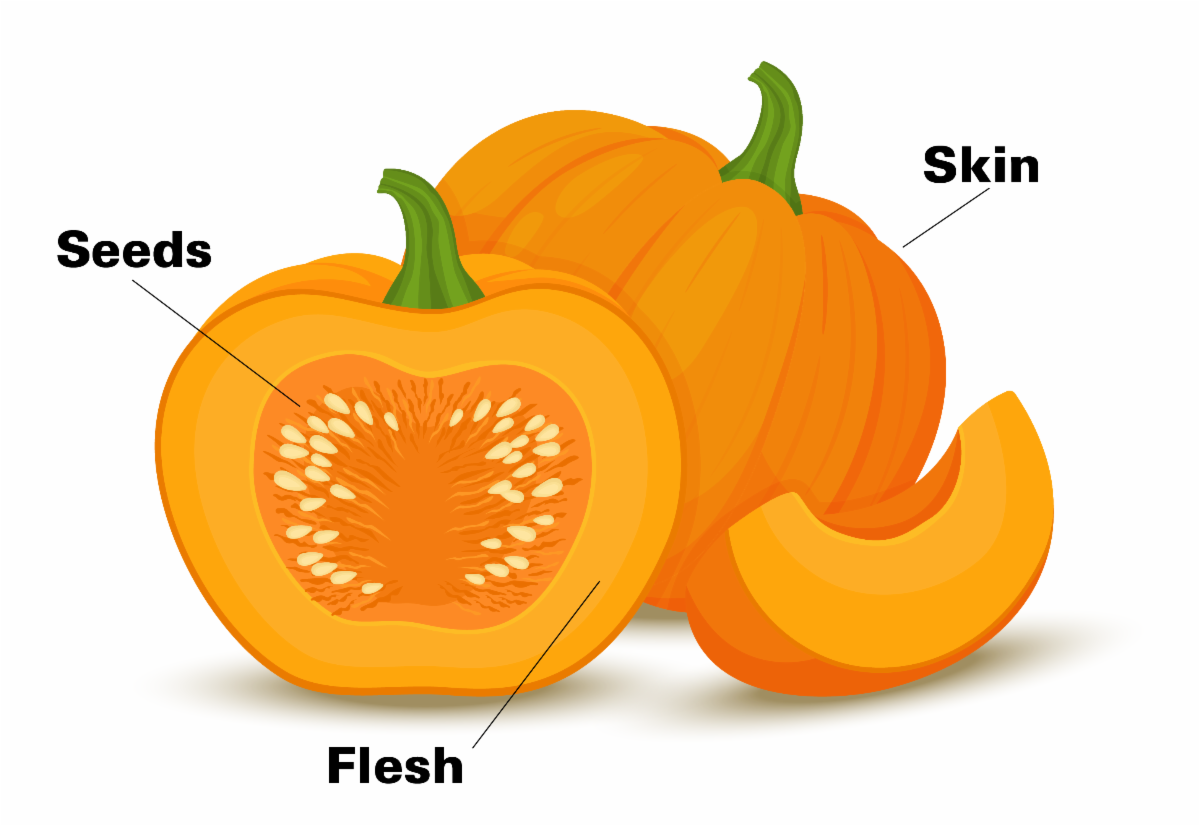Pumpkin Power!

It’s finally Fall! It’s that time of the year for sweaters, warm drinks, and pumpkins! Pumpkins have become a symbol of harvest and festivity. Pumpkins are not only a staple of fall decorations, they start showing up in favorite dishes, and in that way, they can enhance your diet with great nutrition.
Every part of the pumpkin can be used to increase the antioxidant capacity and diversify the texture and taste of your diet! Pumpkins are a good source of
vitamin A (important for vision and growth) and copper (important for red blood cell formation and nerve health). Pumpkin skins, flesh, and seeds are also high in the phytochemicals carotenoids and terpenoids.1
Pumpkin Skin
Orange pumpkin skins are high in carotenoids which can prevent, and sometimes treat, skin and eye disease. However, the skin of the pumpkin is often discarded because of the tough waxy texture. In order to add this boon of phytochemicals into your diet, you can simmer the skin along with other vegetable scraps to create a flavorful stock base for soups and sauces. Another option is to transform pumpkin skin into chips by seasoning and baking until crispy. As with all fresh produce, wash just prior to using as a good food safety practice.
Pumpkin Flesh
Take your porch decor to a new level by “harvesting” the pumpkin flesh from your fall display (as long as it’s still firm when you’re ready to switch seasons)*. Pumpkin flesh can be used in pumpkin pies and breads, even soft pumpkin cookies or pancakes, but why not add pumpkin flesh to savory dishes as well? The flesh is high in vitamin A, low in calories and fat.
Learn how to make roasted pumpkin puree here. For convenience, many recipes call for canned pumpkin, but you can substitute 2 cups of fresh pumpkin puree. Try this Pumpkin Chili recipe for a hearty, savory option. Energy bites are a great mid-day protein boost; try these Pumpkin Energy Bites for seasonal flair. For your fall charcuterie board, include Pumpkin hummus for a twist on a traditional dip.
Pumpkin Seeds
Pumpkin seeds, also known as pepitas, are the edible seeds of pumpkins and other types of squash (yes, pumpkins are botanically part of the squash family). One of the most noteworthy aspects of pumpkin seed is the high magnesium content. Magnesium is a vital mineral involved in numerous physiological processes, including muscle and nerve function, bone health and blood sugar regulation.2
In addition to vitamin and mineral content, pumpkin seeds are rich in dietary fiber and healthy fats, including monounsaturated and polyunsaturated fats. These fats help promote satiety and provide a source of long-lasting energy.3 Incorporating these seeds into your diet can be as simple as adding them to salads, oatmeal, yogurt, or using them as a topping for various dishes. They are easy to make at home and season to your liking; learn how from NC Cooperative Extension.
The best way to maintain a healthy lifestyle is to eat a variety of fruits and vegetables. With an abundance of pumpkins each fall, look for ways to incorporate more pumpkin in your diet and enhance your carotenoid and terpenoid intake!
*To avoid food safety concerns, do not eat pumpkins that have been carved into jack-o-lanterns; only eat pumpkins that are whole. You may have heard of a distinction between carving pumpkins and baking pumpkins. Both are edible, but baking pumpkins may have a richer flavor. Try them both!
Citations
1. Preedy, V. R., & Patel, V. B. (Eds.). (2021). Cancer: oxidative stress and dietary antioxidants. Academic Press.
2. Alasalvar, C., Chang, S. K., Bolling, B., Oh, W. Y., & Shahidi, F. (2021). Specialty seeds: Nutrients, bioactives, bioavailability, and health benefits: A comprehensive review. Comprehensive Reviews in Food Science and Food Safety, 20(3), 2382-2427.
3. Batool M, Ranjha MMAN, Roobab U, Manzoor MF, Farooq U, Nadeem HR, Nadeem M, Kanwal R, AbdElgawad H, Al Jaouni SK, Selim S, Ibrahim SA. Nutritional Value, Phytochemical Potential, and Therapeutic Benefits of Pumpkin (Cucurbita sp.). Plants (Basel). 2022 May 24;11(11):1394.
This article was part of the October 2023 e-news FRESH Rx. Subscribe for similar content delivered to your inbox monthly.
- Categories: